AERO2463 Computational Engineering Analysis Assignment 4
School of Engineering
Computational Engineering Analysis AERO2463
Assignment 4
4.1 Curve Fitting - Polynomial Fitting of Data
4.2 Finite Differences and Differential Equations
School of Engineering
Computational Engineering Analysis - AERO2463
Assignment 4.1
Curve Fitting - Polynomial Fitting of Data
Assessment:
The MATLAB Assignment 4.1 is worth 5%.
Objectives:
Generate curves by fitting data using polynomials
Submission Instructions:
- There are two m-files provided to you on Canvas. One is the template for the function file you are to submit and the other is a script file that you should use to test your function file (please do not submit the script file used for testing your function).
- Submit a single function m-file via Canvas before submission due date specified above.
- Note that the Last Name and Student ID are required as a comment line at the beginning of the m-file, but after the function header.
- The m-file submitted on Canvas should be named as:
o LastName_StudentID_polynomial_fitting.m (write your function in this one)
- Do not zip any files.
- Failure to submit before the deadline will require a reasonable explanation and approval from the Course Coordinator before any later submission can be accepted.
- RMIT late assignment submission policy will apply (10% deduction of marks for each day delay).
- Use the Special Consideration process for any submission later than one week.
- Submit only the files related to the Assignment 4.1.
Background
When dealing with data from experiments or computations, the data will be discrete and not have uniform spacing. Fitting the data within a polynomial can help to predict outputs and to deal with the data in further calculations.
The aim of fitting your discrete data to a polynomial is to be able to predict a value of the dependent variable in terms of the independent variable for those values which do not have corresponding discrete data. Depending on the relationship of the variables, polynomials of different orders should be used to find a good fit between the polynomial and the real data. In the figure shown below, real measurements of liquid water density were taken in increments of 10 °C and several polynomials were calculated using polyfit()to see the correlation between them and the discrete data.
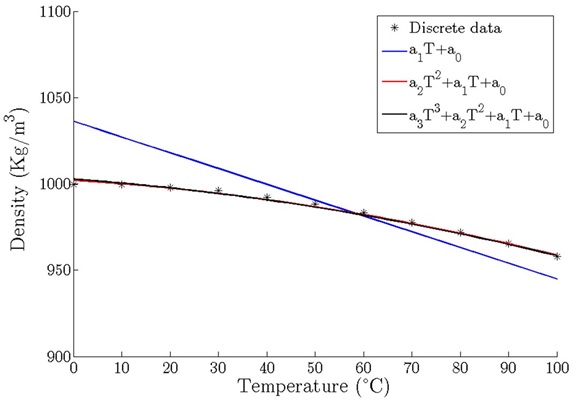
After a polynomial is obtained, we can try to interpolate or extrapolate y-values for any x-value. Be careful if you are extrapolating outside the boundaries of your discrete data, the polynomial could fit well inside your data, but maybe it does not represent well the reality outside them. What is the density of liquid water (pressurized) for temperatures greater that 100°C? In the figure above, we can try to extrapolate them, but we do not know if the physical phenomena will be still fitting our polynomials.
Task
Your task is to write a function which takes two vectors, x (independent variable) and y (dependent variable), and fits polynomials from order 1 (linear relation) up to order 10 (or the maximum order possible for the data size). The function should plot the x and y data with markers (no line) and plot each fitted polynomial (with lines), all on the same plot axis. In a separate figure (or in separate plots within one figure using subplot), plot the interpolated/extrapolated y value for a given x-point defined by the user.
Coding Requirements
- Use the MATLAB built-in function polyfit.
- You should not make any sub-functions inside the function.
- Ensure the x and y data given to the function have the same length. If it is not the case, the function MUST use the error() function to give the user an error message and exit.
- There must NOT be any user interaction within the function.
- To fit a function with a polynomial of an order (also called grade or degree) “n” there must be at least “n+1” points. Your code MUST detect if the number of points is not sufficient enough and show an error message before trying to calculate wrong polynomials.
- The user will enter the x and y vectors to the function from the script, and it will also specify a point “x2” which the function will use to extrapolate its value y(x2) using all the polynomials calculated.
- You should create extra x-points in your function to make the polynomial line plots smoother using more points.
- If the given data fits exactly a polynomial of an order lower than 10, your function MUST NOT plot the polynomials of a greater order. You could use a tolerance to test this.
Hint: In order to fulfill requirement number 8, you should compare your coefficients with a certain tolerance (e.g 10e-6) if you calculate your polynomial, and from certain coefficient all the higher order coefficients (beyond it) are lower than the tolerance, you may assume that it is a perfect fit for a polynomial, excluding those higher order coefficients (i.e. they are equal to zero).
Examples
Example 1
In this first example, the data fits exactly an order 2 polynomial, therefore the code will only plot two polynomials (order 1 and 2)
The user will produce a call to the function in the workplace such as:
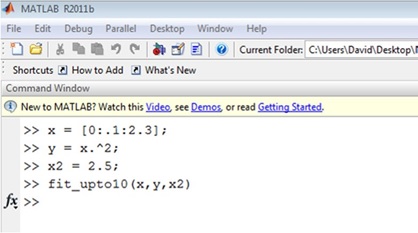
In this case, the function output will produce two plots. The first one is the polynomial fits with the original data. As the polynomial of order 2 fits exactly the function, only 2 polynomials have to be plotted.
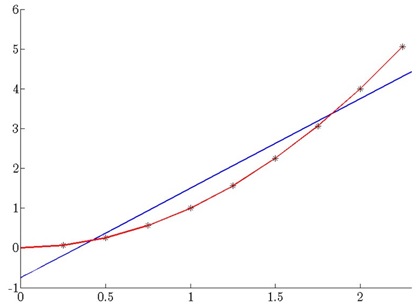
The second plot output contains the predictions at position x2 (x-axis is polynomial order, y-axis is the predicted y value). You have to plot only the number of predictions of the plotted polynomials. As in this case the original data was a perfect x^2 relation, we expect all polynomials of this order or greater to perfectly fit the data and extrapolate the same value. In this subplot you can choose between plotting the guesses of all the polynomials or plot only those guesses for the polynomials shown in the previous figure.
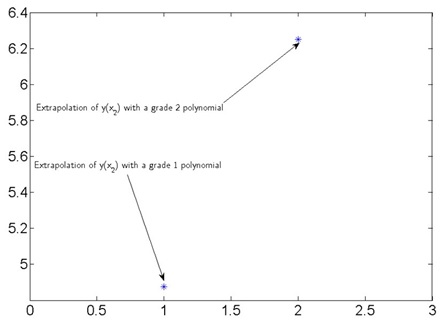
Example 2.
In this case, the fitting will not be perfect with any polynomial, and the code will have to plot all the required polynomials:
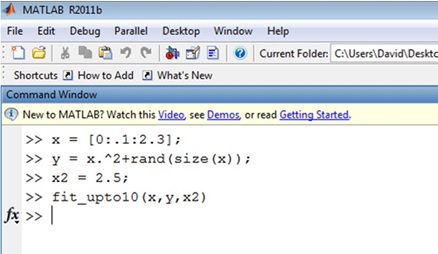
The two plots produced will look like the ones below:
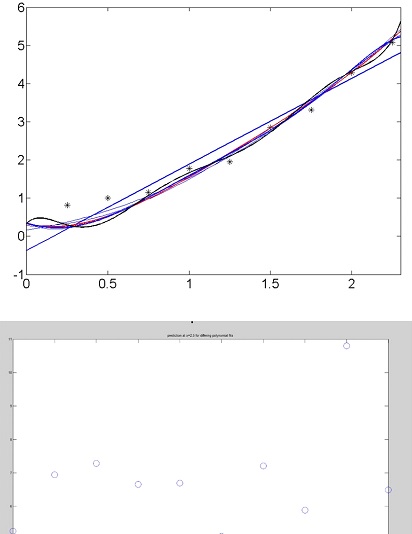
The small amount of scatter in the data leads to dramatically different predictions of the data at an x value of 2.5 (the last known data point was 2.3).
The lesson to be learnt here is: Never extrapolate data with a polynomial unless you know the data is governed by a polynomial of a given order.
When creating software it is very important to ensure your program satisfies the requirements.
Requirements are often very specific as your software may need to interact with user and/or other software components in a very specific way.
Please heed the following warning and ensure your program meets all the requirements described herein before submitting it.
Assessment
Correctly plots fitted polynomials as specified 60%
Correctly plots interpolated/extrapolated y-value for user input x-value in separate plots 20%
If data set mathches a polynomial, higher-order polynomials are not fitted or plotted 20%
Code does not produce error message if x and y are of different size. -20%
Code does not produce error message applied to data set with less than 11 points. -20%
Appropriate deductions for not meeting requirements (e.g. wrong file name) -20%
IMPORTANT: HINTS (DOs and DON’Ts)
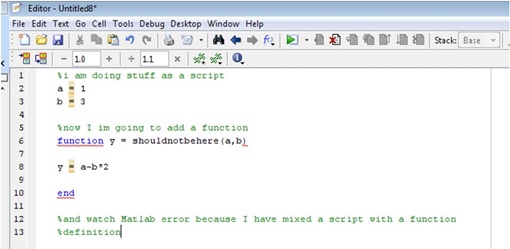
DO NOT PLACE CODE ABOVE YOUR FUNCTION DEFINITION. This is mixing a script and function and cannot be done. The user will pass the data they wish to use to the function via the input arguments!
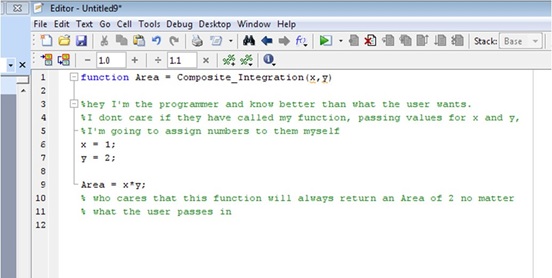
DO NOT STORE SOMETHING TO X, X2 OR Y IN YOUR FUNCTION. If you store values in x, x2 or y in your function, then it will overwrite what the user specified for x, x2 and y.
TEST YOUR CODE: Your code may fit well a provided set of data (but it may not fit for another data set). Make up your own data (that you know the answer to) and test that your function returns the correct results.
TUTORIALS: Please do the learning exercises in the tutorials. They will teach you the skills necessary to do this task.
School of Engineering
Computational Engineering Analysis - AERO2463
Assignment 4.2
Finite Differences and Differential Equations
Assessment:
The MATLAB Assignment 4.2 is worth 5%.
Objectives:
Solve a mechanics problem to calculate the displacement, strain and stress in a 1D elastic structure using the Finite Difference Method.
Submission Instructions:
- You should submit ONE function m-file.
- In the m-file code, you MUST write your name and student ID as a comment line in the mfile.
- Use the templates provided on Canvas.
The m-file should be named as: Last Name_Student ID_FiniteDifference.m (write your function in here)
Please note: You will have to include the same function name as the above file name inside your function file to run it.
- Do not zip the file.
- Failure to submit the assessment solution file through Canvas before the end of submission date and time will need special consideration approval from the coordinator to re-submit (with reasonable explanation).
- In that case, RMIT policy of late assignment submission will apply (10% deduction of marks for each day delay).
- Another m-file calledm is provided to try and call your function. Do NOT submit this file.
AERO2463 Computational Engineering Analysis: Assignment 4, 2018
Problem:
Consider the example of a compression or tensile mechanical test. A sample one-dimensional rod or beam type structure is placed in the tensile test machine. One end is fixed whereas the other end is subject to an imposed displacement. This displacement generates strains and stresses in the structure.
We consider the 1D configuration described by the figure below:
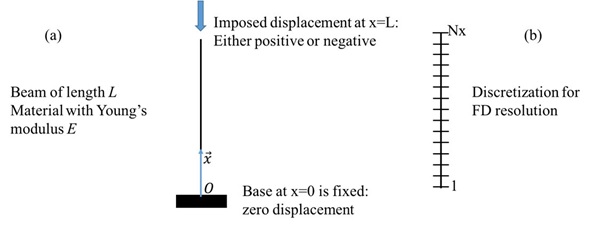
We consider a static problem, where a specific displacement is imposed on a simple 1D rod structure. One end of the rod is fixed (zero displacement) at x=0, and a displacement of value D is imposed at the other end at x=L.
Objective: The aim is to determine the displacement field in the structure for a given displacement at the end point, as well as the strain and stress field, using a second order Finite Differences (FD) method.
The strain ( ) relation is given by the following equation for the current 1D problem:
The stress is then computed as:
where E is the Young’s modulus.
The 1D equation of equilibrium in the absence of an external force is given by. 0
which in 1D corresponds to
This last equation needs to be solved with the Finite Differences method. The structure of length L will be discretized (divided) into Nx elements (segments), as shown in the figure above. Here are some hints describing the intermediate steps required to solve this problem numerically.
AERO2463 Computational Engineering Analysis: Assignment 4, 2018
- Using the expansion in Taylor series, write the central difference scheme for the second order partial derivative ⁄ . This will be true for interior nodes 2 to Nx-1. Special care must be taken for the first and last nodes.
- For the first node (x=0) the displacement is labeled . The value of this displacement is known since it is a boundary condition, 0. We account for the first term as follows:
1 0
- For the last node, (x=L) the displacement is labeled . This displacement is also known because it is the second boundary condition: . Similarly, we account for the last term as follow:
1
- You now have a general scheme for node ∈ 2, 1 , and a simple relation for the first node 1, and the last node . That is all you need to construct a linear system, where U is the unknown vector of displacement to be computed, is a square matrix defined from the FD scheme above, and B is a vector containing the imposed displacement.
Construct a square matrix of dimension Nx × Nx to write the linear system .
Then, you can start programming in MATLAB.
- In your MATLAB function Last Name_Student ID_FiniteDifference.m, you need to:
- Discretize the geometry (divide L in Nx-1 segments or cells, to have Nx nodes).
- Construct the matrix (start with a zeros (of size Nx) matrix and use a for loop to modify the non-zero terms). First and last columns need to be defined separately to incorporate boundary conditions.
- Construct a vector B to store the imposed displacement.
- Solve the problem to obtain the displacement U by inverting the linear system. Plot the displacement field along the structure.
- Compute the strain from the displacement. Plot the strain along the structure.
- Compute the stress and plot it along the structure. What do you observe and conclude?
Your function must produce 3 plots (displacement, strain and stress along the length of the rod structure) and return 2 vectors X and U, respectively, for the discretized domain and the displacement. Since the strain and stress are calcualted for each 1D segment (element), these can be plotted against the displacement at the upper node for that corresponding segment.
Assessment Criteria
- Correct implementation of the FD scheme for displacement 60%
- Correct computation of strains and stresses 20%
- Correct plotting 20%
- Renaming function, inputs or outputs -25%
- Using a built-in ODE solver -25%
Diploma Universities Assignments
Laureate International Universities Assignment
Holmes Institute Assignment
Tafe NSW
Yes College Australia
ACC508 Informatics and Financial Applications Task 2 T2, 2019
ACC512 Accounting
ACC520 Legal Regulation of Business Structures Semester 2, 2019
ACCT20074 Contemporary Accounting Theory Term 2 Assessment 3
AERO2463 Computational Engineering Analysis : Assignment 4
B01DBFN212 Database Fundamentals Assessment 1
BE01106 - Business Statistics Assignment
BFA301 Advanced Financial Accounting
BFA504 Accounting Systems Assessment 3
BSB61015 Advanced Diploma of Leadership and Management
BSBADV602 Develop an Advertising Campaign
BSBCOM603 Plan and establish compliance management systems case study
BSBCOM603 Plan and establish compliance management systems Assessment Task 1
BSBCOM603 Plan and establish compliance management systems Assessment Task 2
BSBCOM603 Plan and establish compliance management systems Assessment Task 3
BSBFIM501 Manage Budgets And Financial Plans Assessment Task 1
BSBHRM602 Manage Human Resources Strategic Planning
BSBINM601 Manage Knowledge and Information
BSBWOR501 Assessment Task 3 Plan Personal Development Plan Project
BSBMGT517 Manage Operational Plan
BSBWHS521 Ensure a Safe Workplace For a Work Area
BSBWRK510 Manage employee relations
BUSS1030 Accounting, Business and Society
CAB202 Microprocessors and Digital Systems Assignment Help
CHC40213 Certificate IV in Education Support
CHCAGE001 Facilitate the empowerment of older people
CHCAGE005 Provide support to people living with dementia
CHCCCS023 Support independence and wellbeing
CHCCCS025 Support relationships with carers and families
CHCCOM005 Communicate and CHCLEG001 Work Legally Ethically
CHCDIS002 Follow established person-centred behaviour supports
CHCECE019 Early Childhood Education and Care
CHCHCS001 Provide home and community support services
COMP10002 Foundations of Algorithms
COMP90038 Algorithms and Complexity
COSC2633/2637 Big Data Processing
COSC473 Introduction to Computer Systems
CPCCBC5011A Manage Environmental Management Practices And Processes In Building And Construction
CPCCBC5018A Apply structural Principles Medium rise Construction
CSE3OSA Assignment 2019
ELEC242 2019 Session 2
ENN543 Data Analytics and Optimisation
ENN543 Data Analytics and Optimisation Semester 2, 2019
FINM202 Financial Management Assessment 3 Group Report
Forensic Investigation Case Assignment ECU University
HA2042 Accounting Information Systems T2 2019
HC1010 Holmes Institute Accounting For Business
HC2112 Service Marketing and Relationship Marketing Individual Assignment T2 2019
HC2121 Comparative Business Ethics & Social Responsibility T2 2019
HI5002 Holmes Institute Finance for Business
HI5003 Economics for Business Trimester 2 2019
HI5004 Marketing Management T1 2020 Individual Report
HI5004 Marketing Management T1 2020 Group Report
HI5004 Holmes Institute Marketing Management
HI5014 International Business across Borders Assignment 1
HI5014 International Business across Borders
HI5017 Managerial Accounting T2 2019
HI5017 Managerial Accounting T1 2019
HI5019 Tutorial Questions 1
HI5019 Strategic Information Systems for Business and Enterprise T1 2020
HI5019 Holmes Institute Strategic Information Systems T2
HI5019 T2 2019
HI5019 T1 2019
HI5020 Corporate Accounting T3 2019
HI5020 Corporate Accounting T2 2019
HI6005: Management and Organisations in a Global Environment
HI6006 Tutorial questions
HI6006 Competitive Strategy Individual T1 2020
HI6006 Holmes Institute Competitive Strategy
HI6006 Competitive Strategy T3 2019
HI6007 Statistics for business decisions
HI6007 Assessment 2 T1 2020
HI6007 T1 2019
HI6008 T2 2019
HI6008 Holmes Institute Research Project
HI6025 Accounting Theory and Current Issues
HI6026 Audit, Assurance and Compliance Assignment Help
HI6026 Audit, Assurance and Compliance
HI6027 business and corporate law tutorial Assignment T1 2021
HI6027 Business and Corporate Law T3 2019
HI6027 Business and Corporate Law T2 2019
HI6028 Taxation Theory, Practice and Law T2 2021
Hi6028 taxation theory, practice and law Final Assessment t1 2021
HI6028 Taxation Theory, Practice and Law T2 2019
HI6028 Taxation Theory T1 2019
HI6028 Taxation Law Holmes
HLTAAP001 Recognise healthy body systems
HLTWHS002 Follow safe practices for direct client care
HOTL5003 Hotel Property and Operations
HPS771 - Research Methods in Psychology A
HS2021 Database Design
ICTICT307 Customise packaged software applications for clients
IFN619 Data Analytics for Strategic Decision Makers
INF80028 Business Process Management Swinburne University
ISY2005 Case Assignment Assessment 2
ISYS326: Information Systems Security Assignment 2, Semester 2, 2019
ITAP3010 Developing Data Access Solutions Project
ITECH1103- Big Data and Analytics – Lab 3 – Working with Data Items
ITECH1103- Big Data and Analytics Assignment Semester 1, 2020
ITECH 5500 Professional Research and Communication
Kent Institute Australia Assignment
MA5830 Data Visualisation Assignment 2
MGMT7020 Project Management Plan
Mgt 301 Assessment 3
MGT215 Project Management Individual Assignment
MIS102 Data and Networking Assignment Help
MITS4002 Object Oriented Software Development
MITS5002 Software Engineering Methodology
MKT01760 Tourism Planning Environments Assessment 4
MKT01760 Tourism Planning Environments
MKT01906 International Tourism Systems
MKT5000 Marketing Management S2 2019
MNG03236 Report Writing SCU
MRE5003 Industrial Techniques In Maintenance Management Assignment 4
MRE5003 Industrial Techniques In Maintenance Management Assignment 3
MRE5003 Industrial Techniques In Maintenance Management
Network Security and Mitigation Strategies Answers
NIT2213 Software Engineering Assignment
NSB231 Integrated Nursing Practice Assessment Task 1
Science Literacy Assessment 4
SIT323 Practical Software Development T 2, 2019
SIT718 Using aggregation functions for data analysis
SITXCOM002 Show Social and Cultural Sensitivity
TLIL5055 Manage a supply chain
TLIR5014 Manage Suppliers
USQ ACC5502 Accounting and Financial Management
UTS: 48370 Road and Transport Engineering Assessment 2
CHCAGE001 Facilitate the empowerment of older people
CHCAGE005 Provide support to people living with dementia
CHCCCS011 Meet personal support needs
CHCCCS015 Provide Individualised Support
CHCCCS023 Support independence and wellbeing
CHCCCS025 Support relationships with carers and families
CHCCOM005 Communicate and work in health or community services
CHCDIS001 Contribute to ongoing skills development
CHCDIS002 Follow established person-centred behaviour supports
CHCDIS003 Support community participation and social inclusion
CHCDIS005 Develop and provide person-centred service responses
CHCDIS007 Facilitate the empowerment of people with disability
CHCDIS008 Facilitate community participation and social inclusion
CHCDIS009 Facilitate ongoing skills development
CHCDIS010 Provide person-centred services
CHCDIV001 Work with diverse people
CHCHCS001 Provide home and community support services
CHCLEG001 Work legally and ethically
CHCLEG003 Manage legal and ethical compliance
HLTAAP001 Recognise healthy body systems
HLTAID003 Provide First Aid
HLTHPS007 Administer and monitor medications
HLTWHS002 Follow safe work practices for direct client care
Assignment 2 Introduction to Digital Forensics
MGT603 Systems Thinking Assessment 1
MGT603 Systems Thinking Assessment 2
Hi5017 Managerial Accounting T1 2021
HI6028 Taxation Theory, Practice and Law T1 2021
OODP101 Assessment Task 3 T1 2021
ITNE2003R Network Configuration and Management Project
Australia Universities
ACT
Australian Catholic University
Australian National University
Bond University
Central Queensland University
Charles Darwin University
Charles Sturt University
Curtin University of Technology
Deakin University
Edith Cowan University
Flinders University
Griffith University
Holmes Institute
James Cook University
La Trobe University
Macquarie University
Monash University
Murdoch University
Queensland University of Technology
RMIT University
Southern Cross University
Swinburne University of Technology
University of Adelaide
University of Ballarat
University of Canberra
University of Melbourne
University of Newcastle
University of New England
University of New South Wales
University of Notre Dame Australia
University of Queensland
University of South Australia
University of Southern Queensland
University of Sydney
University of Tasmania
University of Technology Sydney
University of the Sunshine Coast
University of Western Australia
University of Wollongong
Victoria University
Western Sydney University
Year 11 - 12 Certification Assignment
Australian Capital Territory Year 12 Certificate
HSC - Higher School Certificate
NTCE - Northern Territory Certificate of Education
QCE - Queensland Certificate of Education
SACE - South Australian Certificate of Education
TCE - Tasmanian Certificate of Education
VCE - Victorian Certificate of Education
WACE - Western Australia Certificate of Education
Assignment Service Australia | CDR Writing Help | TAFE Assignment Help | Perth Assignment Help | Melbourne Assignment Help | Darwin Assignment Help | Adelaide Assignment Help | Assignment Help Victoria | Sydney Assignment Help | Canberra Assignment Help | Brisbane Assignment Help | CDR for Australian immigration | Course For Australian History


